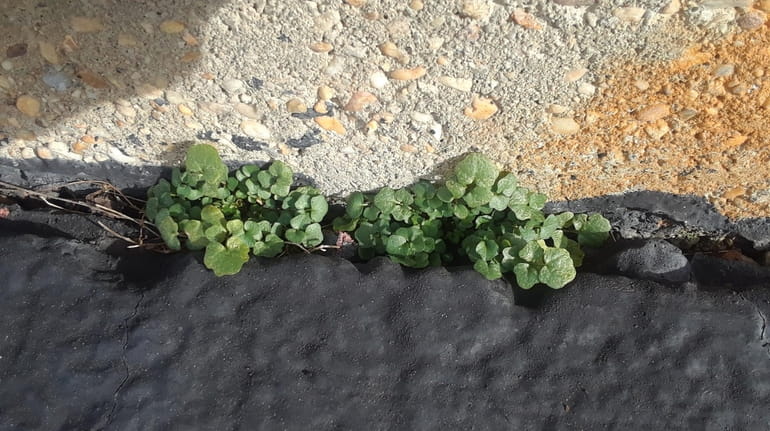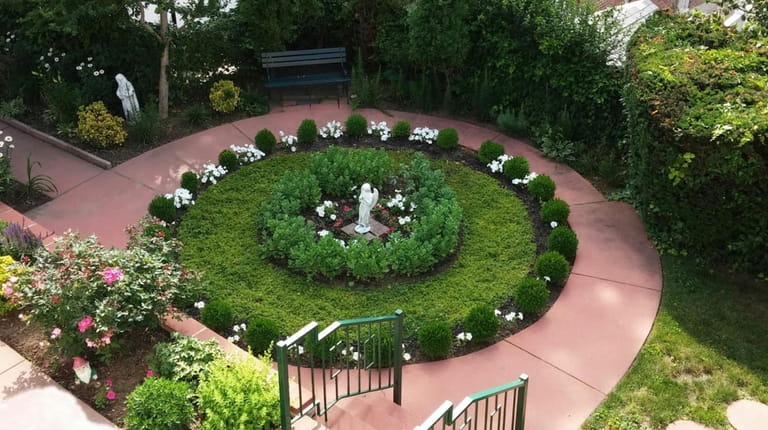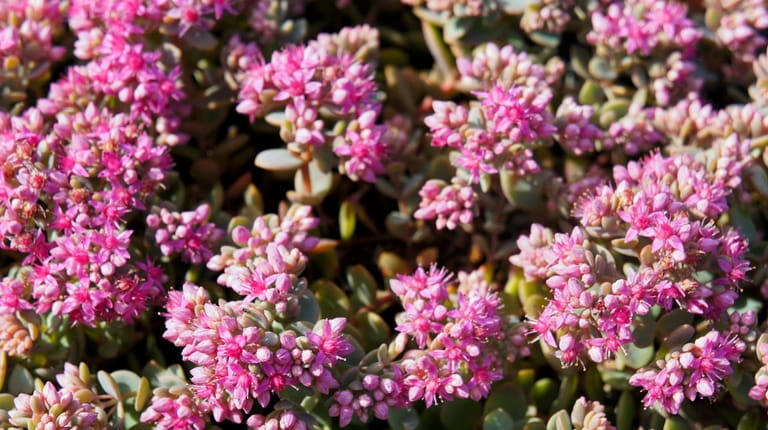How to control bittercress weeds in the lawn and garden

Bittercress growing between pavement cracks in Wantagh. Credit: Carolyn O'Loughlin
DEAR JESSICA: This weed has thrived in my neighbors’ and my lawn and garden beds for about two years. Its early growth resembles a pansy leaf. How do we get rid of it? — Carolyn O’Loughlin, Wantagh
DEAR CAROLYN: You stumped me with this one, so I reached out to Andy Senesac, weed science specialist with the Cornell Cooperative Extension of Suffolk County in Riverhead, who identified your weeds as young seedlings of bittercress. The weed, which looks different when it's mature, is widespread, according to Senesac, and is one of the top five container nursery weeds in the country. Recently, he says, it has been emerging in residential lawns and landscapes such as yours. The plant spreads far and wide because it is one of few plants that produce “exploding” seed pods, which forcefully expel seeds to surrounding areas.
Senesac says the weed has adapted to avoid eradication, but some control can be achieved if lawns are treated in fall with a post-emergence “combination” herbicide. “If the problem isn’t noticed until spring,” he adds, “then an earlier than normal application should be made to prevent a new crop of seeds from maturing.”
In addition, new infestations can be prevented by ensuring a thick lawn. Do this by applying seeds over existing lawns (and repairing bare patches) in late summer. The application of mulch in late fall will smother the weed and help prevent its spread, Senesac says.

A formal boxwood garden in Sean Foley's Queens Village yard. Credit: Sean Foley
DEAR JESSICA: We have a circular garden trimmed with small boxwoods. It has thrived through many winters, but for the past two many of the bushes have been light brown. Can you give us some guidance? — Sean Foley, Queens Village
DEAR SEAN: Your boxwood garden is lovely, conjuring the image of Old World formality, and you've demonstrated that one needn't have an estate the size of Versailles to enjoy one.
Boxwoods sometimes fade a bit over winter, turning brown or orange in spots. You mentioned noticing discoloration over the past two winters, but don't say whether they greened up in spring and summer. If they regained their color during the growing season, your plants are not in danger.
If, however, the browning occurred two winters ago and continues year-round, the shrubs could be afflicted with one of the following diseases:
•The presence of pinkish-orange fruiting bodies on plants during warm, humid weather would indicate Volutella blight, which causes discoloration of leaves in spring that progresses from red to bronze and then yellow as the growing season progresses. Shake dead leaves off plants and trim away infected branches, disinfecting pruners between cuts to avoid spreading disease. Tightly bag removed plant parts and discard in the trash. If the infection is severe, repeated applications of copper fungicide, from early spring through fall, could help protect healthy branches but is not considered a cure.
•Small black dots in a circular pattern on leaves indicate the presence of Macrophoma fungi. Brown leaves should be removed and destroyed. This is most easily done by shaking the plant until dead leaves fall, then raking them up. Bag them tightly and discard in the trash to prevent fungal spores from becoming airborne and reinfecting plants.
•Streaked stems and dark brown leaf spots with black rims are early signs of boxwood blight, for which there is no cure or control. Those early symptoms are followed by severe leaf drop that leaves twigs completely bare. The pathogen can survive on dead plant matter for five years or longer, so fallen leaves should be vacuumed up and bagged for disposal, and infected branches should be pruned during dry weather (when spores will be less active), bagged tightly and discarded in the trash. If control isn't attained with those measures, plants should be removed completely, bagged and discarded.

Sedum spurium cultivars are well-suited for cemetery plantings, as they are attractive, low-growing, low-maintenance and well-behaved. Credit: Getty Images/iStockphoto
DEAR JESSICA: My family has two grave markers that are flush to the ground and side-by-side. I am looking for a pretty ground cover to plant around them. The ideal one would have a long blooming season and would not grow tall. Any suggestions? — Carolyn Pilger, Malverne
DEAR CAROLYN: By definition, ground covers cover the ground — all the ground. What I'm trying to say is most ground covers tend to spread and don't recognize borders like, say, the end of your family plot. So the likelihood your ground cover will invade your neighbors' grave markers is quite high.You can try to contain these plants, but simply creating a border of brick, wood or stone will not likely suffice because many ground covers spread by running underground roots and/or wind-dispersed seeds that will bypass any aboveground barrier you install.
So instead of fast-growing (read: invasive) ground covers, I'd recommend planting one of the Sedum spurium varieties, which have succulent, fleshy leaves. They are low-maintenance, drought tolerant and make for better neighbors, as they are slow- to medium-growing. Varieties such as 'Dragon's Blood' and 'Fulda Glow' have reddish succulent leaves that deepen in color as the weather cools. Both send up reddish flowers during summer and grow to only 4 inches tall. If, after several years, they begin to spread beyond your site, they can be easily contained by trimming.
If you're willing to forgo flowers, you might consider blue rug juniper, a ground-hugging evergreen.
Before planting anything, however, I recommend you check with the cemetery about its rules or guidelines.
